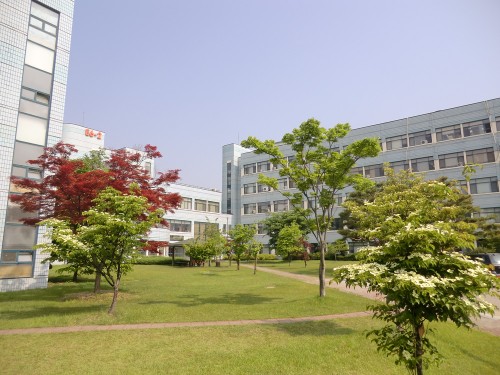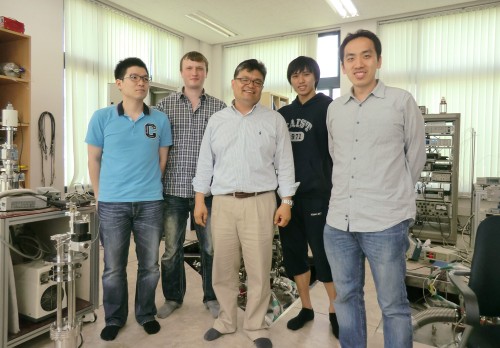
The physics department at KAIST.
By Matin Durrani
Today was the first full day in South Korea for myself and Physics World news editor Michael Banks and it saw us head off by car from our hotel in downtown Daejeon to the massive science and technology zone in the north of the city. Home to more than 1000 research institutes, universities and start-ups, the zone is called Daedeok Innopolis; it’s a kind of putative Silicon Valley, if you like.
While Michael hooked up with researchers at Chungnam National University and then the Korea Research Institute of Standards and Science, I spent the day at the Korean Advanced Institute of Science and Technology (KAIST). My visit had been very kindly arranged by the head of the physics department Hawoong Jeong, a statistical physicist who carries out research into complexity science. Like many of the researchers I met, Jeong had spent part of his career in the US, which is handy for him (and me) given that KAIST dubs itself a bilingual institute, at which almost all lectures are given in English.
KAIST was founded in 1971 to drive forward the country’s research efforts at a time when the nation was starting to shift from one based primarily on agriculture to today’s modern hi-tech society that boasts global industrial powerhouses such as Samsung, LG and Hyundai. The institute, which now has almost 600 full-time faculty staff and nearly 11,000 students, is one of the leading research universities in Asia.
I toured the labs of a number of different staff, including one researcher who is studying how certain proteins made from four helices unwind when stretched, another taking images of molecules cooled to cryogenic temperatures with an ultrasensitive scanning-tunnelling microscope mounted on a floating concrete base, and a third who can image single red-blood cells using just light.

Eun-Seong Kim and colleagues at KAIST’s Center for Supersolid and Quantum Matter Research.
I also caught up with Eun-Seong Kim, best known for his work at Penn State University with his former PhD supervisor Moses Chan, who first mooted the possibility of a new form of matter called a “supersolid” – a mysterious substance that allegedly floats through ordinary solids, like a ghost through walls. Kim moved to KAIST in 2006 and now runs a lab called the Center for Supersolid and Quantum Matter Research. I always felt the name was rather optimistic, given that there has been a fair bit of controversy over whether supersolids actually exist – indeed, Chan himself recently announced that what he and Kim had originally seen was not a new form of matter at all, but a mundane material effect.
Kim briefly pointed out his supersolid experiments, which consist of a tiny sample of solid helium-4 in a porous glass disc embedded in a fat cylindrical can hanging from a rod. Rotate the can back and forth and you will see a sudden drop in the oscillation period that – or so the argument goes – marks the onset of superfluidity in the solid helium-4 . Kim, though, is still confident that supersolidity is real and he showed me more recent data that, he reckons, can be explained only through this effect. But I found Kim fairly philosophical about the whole affair – even if supersolids didn’t exist, then, he said, the whole debate had been an interesting experience to live through.
Supersolids or not, the take-home point for me is that KAIST is investing heavily in this kind of basic research, which is the lifeblood of physics and can lead to all sorts of interesting applications. I was told in fact that KAIST graduates have so far set up some 700 firms and it also has six massive new interdisciplinary institutes devoted to biosciences, nanotech, IT, complex systems and optical science and technology. It has also developed a new form of vehicle technology whereby battery-powered buses, dubbed Online Electric Vehicles, can wirelessly charge up by travelling over special strips laid at intervals on a road.
So while Korea is supporting fundamental science, what struck me is that it also has one eye clearly on its myriad uses.
Yes, the super-solid HE-4 work
by Chan et al that excited a lot of people from the experimental and theoretical side, seems to have lost its luster due to the new work on it by the same Chan et al.